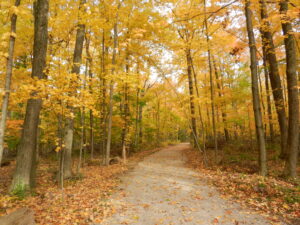By Uriah St. John
Corn, pumpkins, and apples are all crops that remind me of fall. From running through a corn maize as a kid, to sitting down to apple pie at thanksgiving, they’ve always been part of my family’s and many others’ traditions. Did you know though that these plants looked quite different in the wild? So today let’s take a look at these plants, their history, and what they were like historically.

While not originally from Ohio corn, or maize, originated in Central America thousands of years ago as the grass teosinte. First domesticated about 8,000 years ago, teosinte could grow up to 23ft tall, and only had around 8 kernels per ear. While small compared to modern corn, teosinte was big news at the time, and it immediately started spreading along trade routes. It wasn’t until around 1,000 CE, however, that it reached Ohio as modern corn. The fall tradition of a corn maze is an even more recent invention, as it did not appear until the 20th century. Their place of origin is not entirely certain, though it is thought they first appeared in Pennsylvania.

Like corn, pumpkins also originated in Central America around 8,000 years ago. Pumpkins are closely related to squash and gourds, and so the first pumpkins looked very similar to them with a small size and a harder outer skin. It was this hard skin that made them an appealing crop, as it made the fruit more resilient to harsh weather. As with corn, pumpkins spread along trade routes, but stayed small until they reached New England where the Native Americans bred them to their modern size. This larger size was put to good use, in the baking of the first pumpkin “pies”. Not much like our pies, the original pumpkin pies were pumpkins stuffed with apples and nuts and cooked over a fire. The modern pumpkin pie did not appear until the late 1600s.

The last plant we’ll look at is apples. It is the only one of the three not native to the Americas. To find the ancestor of the modern apple you must go to the Tian Shan Mountains in Central Asia. The first wild apples were like crab apples; small and bitter. Like the previous plants, apples were also first cultivated about 8,000 years ago and were bred to be larger and sweeter. From Central Asia they spread along trade routes and reached Northern Europe by 1,500 BCE. There, apples were primarily prized as a source for hard cider; an important drink as the fermentation made it safer than water, and it was easier to produce than beer. It was also in Northern Europe that the first apple pies were made in the 1300s. The apple then made its way to America via the English and Dutch colonists who brought it with them.
So next time you enjoy one of these fall plants take a moment and appreciate the journey they went on to make your season special.






